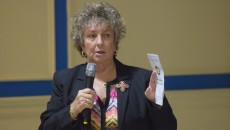After putting in place an expensive new reading program last school year, more students are reading at grade level, according to data presented to the school board on Monday night.
Students in grades 1 and 5 made the biggest improvement with a 6-percent gain. 39-percent of first graders are reading at or above grade level in 2018-19, up from 33-percent a year earlier. Similarly, 39-percent of fifth graders are at grade level or above compared to 33-percent the previous year.
Third graders registered a 5-percent gain, 49-percent in 2018-19 from 44-percent the previous year. Grades K and 4 improved by 1-percent. K climbed to 41-percent and 4 to 44-percent, according to the data.
Number of students reading at grade level in the second grade dropped by 2-percent to 46-percent, according to the data.
“We felt pretty good about first year implementation,” said assistant superintendent Eric Crespo. “That’s not to say that our work is done in improving elementary students’ reading ability, but the data indicates that our efforts are moving in the right direction.”
 Crespo said the data is not comparing “apples to apples” because the comparison is between the old assessments from the 2017-18 school year and new assessments produced after the implementation of the “Wonders” reading program in the 2018-19 school year.
Crespo said the data is not comparing “apples to apples” because the comparison is between the old assessments from the 2017-18 school year and new assessments produced after the implementation of the “Wonders” reading program in the 2018-19 school year.
Students are reading longer texts, said Crespo. He said students are also dealing with higher Lexile level texts. In grade 2, teachers read text and question to students in 2017-18, but in 2018-19 students had to work on their own.
School board members weren’t feeling so well after seeing the data on Monday night. Many wanted to see much more significant gains in one of New Jersey’s lowest performing school districts.
More than half the students in each of the K-5 grades aren’t reading at grade level.
“It does not appear it’s working,” said Jonathan Hodges, longest serving member of the Board of Education. He asked why there was a drop off in grade 2.
Crespo said the test last school year was “more rigorous” relative to the year before. For example, in some cases students went from reading 500 words to 1,200 words in the assessments, he said.
“We’re exposing them to an increased level of rigor,” said Crespo.
“The measures aren’t the same. They drop off because it’s harder,” said school board president Oshin Castillo.
School officials said the first year data from the Wonders program provides a “truer picture” of student reading levels.
“Make no mistake, we want every child enrolled in Paterson Public Schools to be reading at or above their grade level,” said superintendent Eileen Shafer. “Clearly, there’s a lot we need to do in order to make that happen. But this data is encouraging and we will continue our efforts in providing rigorous reading education in the classroom, and fostering a love of reading in our students with the help of our community partners.”
Email: [email protected]



